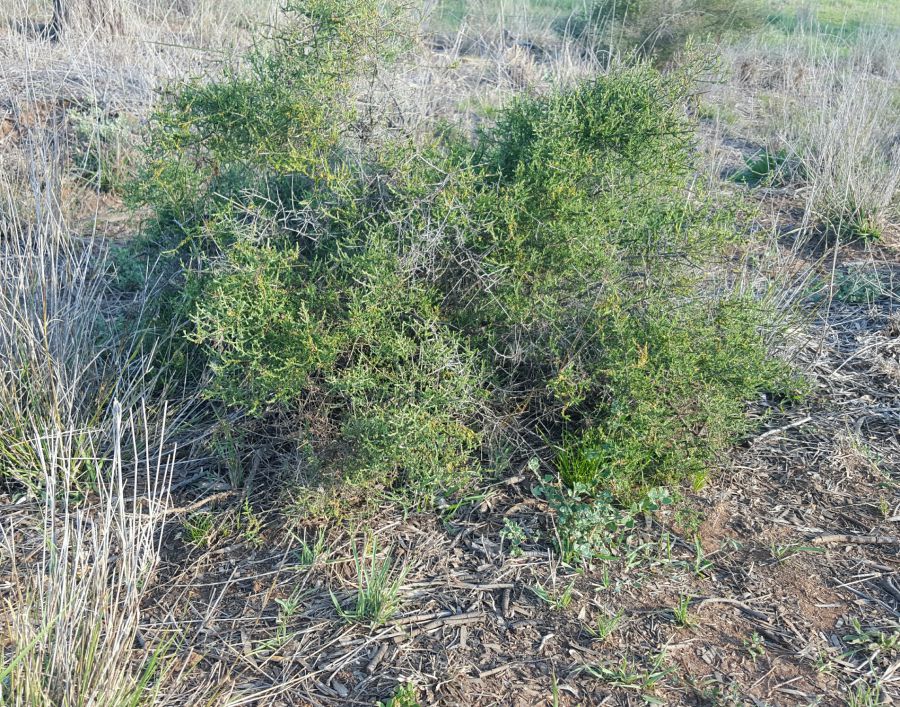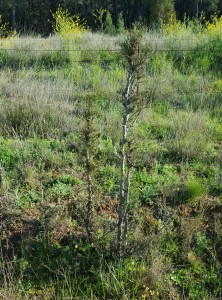I recently spoke with a fellow farmer who was sharing his challenges of perennial weeds – particularly, in this case, mid story native shrubs. This conversation prompted me to think that this was probably a fairly pertinent subject to follow up here on the blog.
If we get our grazing practices right, we know that we can have succession of species towards more stable plant communities and most likely more desirable species for our production systems. So, if there is a season where we have annual weeds, we could use herbicides or mechanical means to control, or we may choose to leave the ground covered with that plant, create conditions favourable to higher succession plants and hang in there hoping that our complex and dynamic ecosystem is being driven in the right direction. Following seasons will likely then see the change to a different species – and possibly a more desirable one. This is because the presence of that annual weed creates changes in the micro-environment around it, which then allows other species to establish that may not have been possible before these micro-environment changes occurred.
Perennial Weeds
What about perennial weeds though? Perennial weeds may be anything from smaller plants like St Johns Wort, to bushes and blackberries and invasive pine.
If perennial plants are able to germinate and establish in one season, unless we actively address their presence – it is likely that they will then persist for many years. [private]Succession may eventually occur past these perennial weeds/plants, but it could be a very long time and may not be in the time frame that is workable for our production systems. ‘Hanging in there’ may not be an option if we are to have profitable farm systems.
Having complex and stable pastures and grasslands with diverse, productive perennial grasses, trees and great ground cover, it is likely we will avoid the proliferation of perennial weeds. For degraded systems however, we have to reach this point before we have the protection of the complex system against perennial weeds.
A small note about ‘weeds’ before I continue. What we consider to be a weed is often a plant that comes in when the conditions for its proliferation are provided, and when present to the point of it being the majority, animals do not thrive feeding on it. Such a plant may be beneficial diversity amongst a complex plant community, but when proliferating, is undesirable for farm production. I have written about the role of ‘weeds’ before.
What has caused the Weed’s Presence?
One of a number of things to consider when faced with the presence of a perennial weed is the environment that allowed this weed to proliferate. How has that environment been created? Think about how the 6 Holistic Management tools for land change (grazing, fire, rest, technology, animal impact, living organisms) have been applied, either consciously or unconsciously? If we identify this, then we can avoid creating these conditions for the weed in the future. More important to consider however is how to harbour the species that we DO want? What are the conditions that we need to create for the plant species that we want to be present and what tools can we use to create these conditions?
These questions are particularly appropriate when moving from an overgrazing situation or case when the soil has been bared for some reason. Sheep especially, have an amazing ability to eat and re-eat plants to the ground when given the chance – to the point that in an overgrazed situation, we may not even be aware of what species are present. The overgrazing may be creating the bare ground needed for perennial weeds to establish, but the pressure from the overgrazing may also be keeping the perennial weed at bay (along with every other species). Changing such a system needs to be monitored carefully. Allowing rest from grazing will allow whatever plants are present to come away. There will be a time period where perennial grasses may have not yet established well, yet rest has been introduced.
Rest or Recovery from Grazing and Brittleness
The effect of rest can have different results depending on the environment. For anyone that has studied Holistic Management, you will know that environments are classified on the brittleness scale of 1 to 10, with 1 being a jungle and 10 a desert. Such environments react differently to the same management, with less brittle environments being more ‘forgiving’ to more poorly planned grazing management and being recognised by more consistently humid conditions.
These environments react differently when rested from grazing. Experience tells us that environments higher on the brittleness scale will not, in the long term, benefit from long term (years) complete rest and in fact, this will be detrimental to pastures. Outcomes like the loss of perennial grasses, loss of species diversity and loss of ground cover are experienced – similar to the outcomes of an overgrazing situation. With this in mind I will discuss partial rest.
Partial Rest
Partial rest is where grazing density is too low and some plants in the paddock are grazed and re-grazed before recovery of leaves and especially the roots (overgrazing), while others are left completely ungrazed. There is overgrazing and undergrazing occurring within the same paddock. This problem is compounded the next time animals are in the paddock, as the plants that were grazed previously have now regrown and are the ‘freshest’ in the paddock and are hence chosen again by the animals to graze and the ungrazed plants remain so. Allan Savory states in Holistic Management handbook that “partial rest can be nearly as destructive as total rest in the more brittle environments”.1 The chapter on Rest from this book is well worth revisiting for those of you that have the book.
Let’s think back to the presence of perennial weeds. It is possible that partial rest has resulted in bare ground and allowed the establishment of the weeds, but as always, endeavour to get to the root cause of the problem. What is causing the bare ground?
‘Control’ of Perennial Weeds
There is always some plant species wanting to fill a void when there has been overgrazing, over resting and/or reduced ground cover. The species that then proliferate are a function of the environment and what is causing the bare ground (things we are doing). If we change or remove the causal agent, we will likely see a change in the plants that exist in the landscape. This can be especially true in certain environments if we are moving from a situation where there has been overgrazing to one of using rest and plant recovery. It is how we manage the grazing and rest and encourage the right conditions for the desirable species that is of great importance. Naturally, however, things don’t always go to plan, and if we do have a perennial weed in our pastures, what might we consider with regard to managing it. This is something I will write of in the next few weeks.
In summary
Land condition is often a function of the tools applied – consciously or unconsciously.
In this context a tool is an action or situation that causes a change to vegetation and/or the soil surface.
These tools fall into six categories – technology, fire, rest, living organisms, grazing, animal impact and it is these tools that we must consider when determining why the weed is present and in managing it into the future.
What are the perennial weed issues of your region? The lighter soils of our region are prone to cotton bush, as seen in the image at the top of this post.
References
- Savory, A. & Butterfield, J. (1999) Holistic Mangement – A New Framework for Decision Making. Island Press, Washington, pg 209


